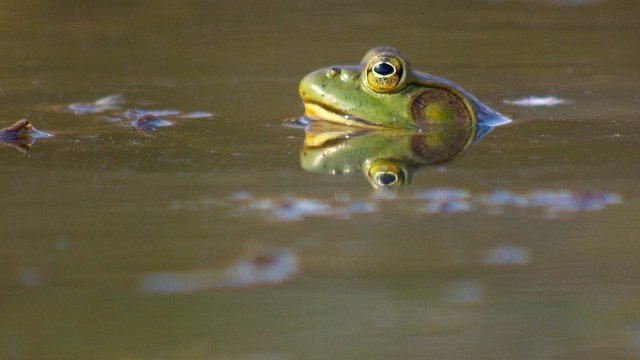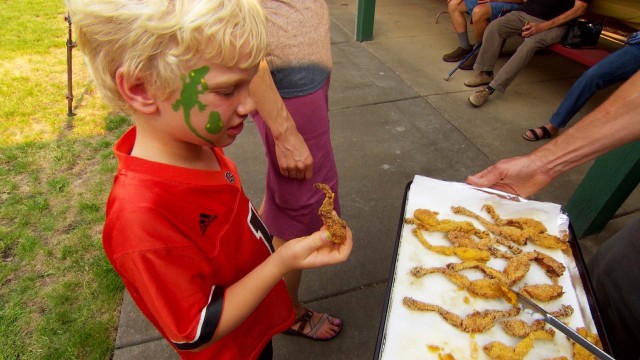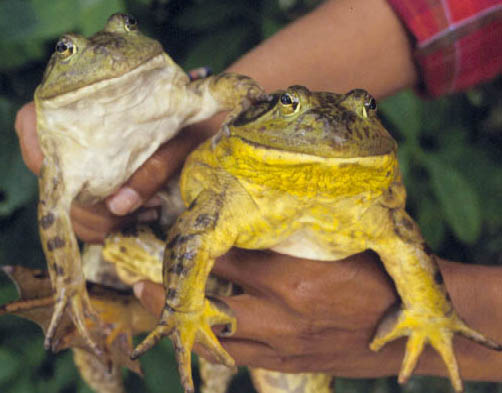
Govindarajulu P, Altwegg R, and Anholt B. 2005. “Matrix Model Investigation of Invasive Species Control: Bullfrogs on Vancouver Island”. Ecological Applications 15.6: 2161-2170. Available from http://www.jstor.org/stable/4543513?seq=1#page_scan_tab_contents (accessed January 19, 2016)
With conservation being such a complicated and complex issue, I always enjoy when someone is able to show that conservation doesn’t always have to be.
This news article was interesting to me because of the applications, it has shown and has led to fun ways of getting the community involved in conservation work. I think a lot of times you see and hear the facts and consequences of humans taking over the planet and being the cause of our own destruction. We are bombarded on a daily basis of the devastating things happening in and to our home, from huge complicated issues like climate change to the example found in this article about the invasive bullfrog populations taking over native ecosystems on Vancouver Island. It becomes very hard to decide which issue we should focus our time, money, and efforts to. A lot of people respond with the attitude that because we can’t fix all the world’s problems, why bother fixing any of them. While attempting to solve global issues is an impossible task for one person, doing what you can, picking one issue and actively working in that field, towards one goal, is ultimately what is going to be most effective.
One approach that Tom Kaye has started to be more effective in his community, is gaining the awareness in Oregon by creating a locally sourced menu strictly of the invasive species in the area, including deep fried bullfrog legs. He is working to raise attention of the public about the trouble that invasive species can cause within an ecosystem. Tom and his family aim to provide their menu of invasives at an annual feast and cooking competition called “Eradication by Mastication.”

Bullfrogs are a known terror, not only in Oregon but all up the coastline and throughout Vancouver Island as well. While eating the bullfrogs raises awareness, further research is needed to fully understand how to tackle this issue and make practical steps to restore this diverse ecological community. The primary source that I found interesting looks at the life cycle of frogs over five years in four different locations around Vancouver Island. The approach of the paper is to investigate the biology of the frog to understand how to control this invasive species and conserve the ecosystem. This study aimed to shows some effective ways to restore the ecosystem by removing the presence of the invasive bullfrogs. They monitored the four locations and removed the bullfrogs during different stages in their life cycle using the capture, mark, and recapture technique. The study shows the bullfrog population would remain strong in numbers when/if the bullfrog made it to post metamorphosis in the life cycle, therefore, encouraging the genetic trend for the frog to metaphorize quickly over one year, instead of two. The article concludes by stating their most effective technique in controlling the bullfrogs was to reduce the metamorph survival rate by removing the frogs during this part of their life cycle as it showed the greatest declines in the population growth rate in the four locations.
While dealing with invasive species is tricky, it can help just to pass along the word and to pass the deep fried frog legs!
Word Count: 534
Featured Image Source: Vancouver Island Special Places

Unique approach by Kaye in Oregon!
LikeLike
Wow, I was not expecting a blog done on eating invasive species! Very unique topic!
LikeLike
Cool article! The kid in that picture does not look impressed with eating frog legs haha
LikeLike
Interesting approach to conservation, I like that he is educating about conservation in a simple way
LikeLike
Not sure how I would feel about eating deep fried frog legs.. but hey, if it’s bringing awareness into the community. Why not? Very innovative way to put conservation biology into a simple light. I also find it interesting that greatest population declines were observed when frogs were removed in the first part of their life cycle, I suppose it makes sense as they would not have reached sexual maturity at that time. All in all cool blog post Ruth!
LikeLike
Sounds tasty! I find myself tempted to try bullfrog now.
LikeLike
This definitely makes me want to try deep-fried bullfrog legs. Chicken feet are good, and I think these frog legs would have a bit more meat to bone ratio anyway. I was surprised at how long the life cycle is.
LikeLike
A very interesting post, Ruth. It is a great approach to bring conservation to the public eye, and increase the awareness of invasive species. I’m a little afraid to try the frog legs though. Hopefully Kaye and his family do well in the cooking competition.
LikeLike
This is such an awesome solution to an invasive. Never thought about eating as conservation before;)
LikeLike